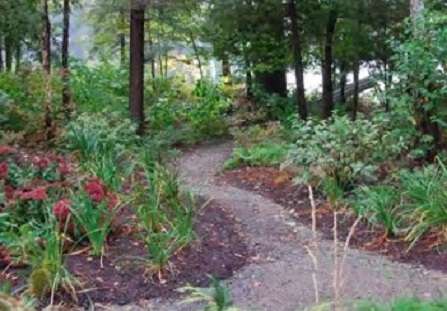LAKE LIFE TODAY: While planning for the Future, part 7
 by Elaine Philbrook
by Elaine Philbrook
Lake Life Today is a series of articles that are hoped will inspire you to see how, by taking just a few steps, you can make a difference and help preserve the quality of water in our lakes for future generations.
These articles have been collected and organized by LakeSmart Director Elaine Philbrook, a member of China Region Lake Alliance (aka “the Alliance”) serving China Lake, Webber Pond, Three Mile Pond, and Three-Cornered Pond. The Alliance would like to thank our partners at Maine Lakes and Lakes Environmental Association (LEA) for information to support this article.
[See the rest of the series here.]Pathways
Do you have a pathway from your home to the lake’s shore? Chances are you do. Water flowing over improperly designed paths and walkways is one of the ways pollutants find their way into our lakes and waterbodies. Properly designed pathways for foot traffic minimize compaction to soils in surrounding areas, help to absorb water, reduce the rate of stormwater runoff flow, protect soil from erosion, and prevent pollutants such as sediments from entering the lake.
What does a properly designed path or walkway look like?
Properly designed pathways are meandering, shed runoff regularly preventing erosion, and stabilize high traffic areas. Stormwater runoff should be directed into adjacent vegetation.
Ideally, paths should be no more than three – four feet wide. The walking surface should be covered with 3 – 4 inches of material such as Erosion Control Mix (ECM), pine needles, wood chips, crushed stone, or other material. This will well-define the path, guide foot traffic, and reduce soil erosion.
Steeper slopes may require water-bars to divert stormwater runoff to vegetated areas, or infiltration steps. These topics will be covered in future articles. Whenever possible avoid steeper slopes for your pathways.
If new pathways are not clearly defined, they can be marked with strategic plantings, stones, solar lights, etc., along the edges. This will show the preferred route for foot traffic.
It is important to maintain your pathways by periodically removing accumulated debris from the surface. Mulched pathways may need to be re-shaped and additional material may be needed to replace what has washed or worn away.
For more information about pathways take a moment to read this helpful information sheet: https://dec.vermont.gov/sites/dec/files/documents/LakeWiseInfoSheet_PlanningPathways.pdf.
If you have any questions about what you can do to ensure the integrity of your valued lake or if you would like a free LakeSmart evaluation you can reach Elaine Philbrook by email at chinalakesmart@gmail.com and follow-up to read the next Town Line Newspaper.
Live lightly on the land for the sake of the lake (LakeSmart).
Responsible journalism is hard work!
It is also expensive!
If you enjoy reading The Town Line and the good news we bring you each week, would you consider a donation to help us continue the work we’re doing?
The Town Line is a 501(c)(3) nonprofit private foundation, and all donations are tax deductible under the Internal Revenue Service code.
To help, please visit our online donation page or mail a check payable to The Town Line, PO Box 89, South China, ME 04358. Your contribution is appreciated!


Leave a Reply
Want to join the discussion?Feel free to contribute!